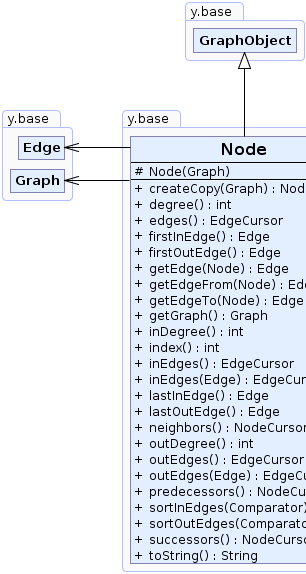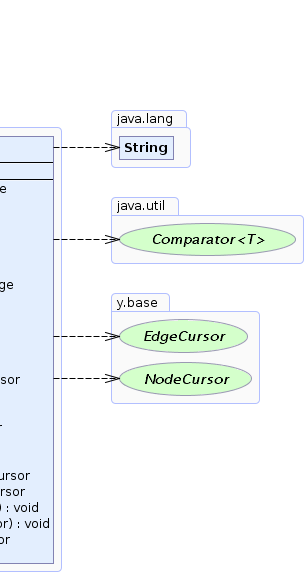 y.base.Node
y.base.Node
|
Search this API | ||||||||
| PREV CLASS NEXT CLASS | FRAMES NO FRAMES | ||||||||
| SUMMARY: NESTED | FIELD | CONSTR | METHOD | DETAIL: FIELD | CONSTR | METHOD | ||||||||
java.lang.Objecty.base.Node
public class Node
Represents a so-called node in the directed graph data type Graph.
Most notably, a node provides access to its adjacent edges (represented by instances
of class Edge).
These can be distinguished into the sets of incoming and outgoing edges.
edges(),
inEdges(), outEdges()).
Also supported is iteration over all nodes at opposite ends of either incoming
edges or outgoing edges (predecessors(), successors()).
The number of overall edges at a node is called its degree (degree()),
which is the sum of incoming and outgoing edges (inDegree(),
outDegree()).
Important:
Class Graph is the single authority for any structural changes to the graph data
type.
Specifically, this means that there is no way to create or delete a node or an
edge without using an actual Graph instance.
 |
 |
| Constructor Summary | |
|---|---|
protected |
Node(Graph g)
Instantiates a new Node object that will be part of the given graph. |
| Method Summary | |
|---|---|
Node |
createCopy(Graph g)
Creates a copy of this node that will be inserted into the given graph. |
int |
degree()
Returns the overall number of incoming and outgoing edges at this node. |
EdgeCursor |
edges()
Returns an edge cursor for all incoming and outgoing edges at this node. |
Edge |
firstInEdge()
Returns the first incoming edge at this node, or null if it does
not exist. |
Edge |
firstOutEdge()
Returns the first outgoing edge at this node, or null if it does
not exist. |
Edge |
getEdge(Node opposite)
Returns an edge that connects this node with the given node, if such an edge exists. |
Edge |
getEdgeFrom(Node source)
Returns an incoming edge that connects the given node with this node, if such an edge exists. |
Edge |
getEdgeTo(Node target)
Returns an outgoing edge that connects this node with the given node, if such an edge exists. |
Graph |
getGraph()
Returns the graph this node belongs to. |
int |
inDegree()
Returns the number of incoming edges at this node. |
int |
index()
Returns the index of this node within its graph G. |
EdgeCursor |
inEdges()
Returns an edge cursor for all incoming edges at this node. |
EdgeCursor |
inEdges(Edge startEdge)
Returns an edge cursor for incoming edges at this node. |
Edge |
lastInEdge()
Returns the last incoming edge at this node, or null if it does
not exist. |
Edge |
lastOutEdge()
Returns the last outgoing edge at this node, or null if it does
not exist. |
NodeCursor |
neighbors()
Returns a node cursor for all neighbor nodes of this node. |
int |
outDegree()
Returns the number of outgoing edges at this node. |
EdgeCursor |
outEdges()
Returns an edge cursor for all outgoing edges at this node. |
EdgeCursor |
outEdges(Edge startEdge)
Returns an edge cursor for outgoing edges at this node. |
NodeCursor |
predecessors()
Returns a node cursor for all predecessor nodes of this node. |
void |
sortInEdges(java.util.Comparator c)
Sorts incoming edges at this node according to the given comparator. |
void |
sortOutEdges(java.util.Comparator c)
Sorts outgoing edges at this node according to the given comparator. |
NodeCursor |
successors()
Returns a node cursor for all successor nodes of this node. |
java.lang.String |
toString()
Returns a String representation of this node. |
| Methods inherited from class java.lang.Object |
|---|
clone, equals, finalize, getClass, hashCode, notify, notifyAll, wait, wait, wait |
| Constructor Detail |
|---|
protected Node(Graph g)
g - The graph that the created node will belong to.| Method Detail |
|---|
public Node createCopy(Graph g)
g - The graph that the created node will belong to.
public int degree()
Edge,
inDegree(),
outDegree()public int inDegree()
degree(),
outDegree()public int outDegree()
degree(),
inDegree()public int index()
>= 0 and < G.nodeCount().
Note that indices are subject to change whenever the sequence of nodes in a
graph is modified by either removing, hiding, reinserting, or unhiding a node,
or by explicitly changing its position in the sequence.
Graph.removeNode(Node),
Graph.hide(Node),
Graph.reInsertNode(Node),
Graph.unhide(Node),
Graph.moveToFirst(Node),
Graph.moveToLast(Node)public Graph getGraph()
null.
public Edge firstOutEdge()
null if it does
not exist.
firstInEdge(),
lastOutEdge()public Edge firstInEdge()
null if it does
not exist.
firstOutEdge(),
lastInEdge()public Edge lastOutEdge()
null if it does
not exist.
firstOutEdge(),
lastInEdge()public Edge lastInEdge()
null if it does
not exist.
firstInEdge(),
lastOutEdge()public EdgeCursor edges()
inEdges(),
outEdges()public EdgeCursor inEdges()
edges(),
outEdges()public EdgeCursor inEdges(Edge startEdge)
inEdges().
startEdge is an incoming edge at this node.startEdge - The first edge being accessed by the returned cursor.outEdges(Edge)public EdgeCursor outEdges()
edges(),
inEdges()public EdgeCursor outEdges(Edge startEdge)
outEdges().
startEdge is an outgoing edge at this node.startEdge - The first edge being accessed by the returned cursor.inEdges(Edge)public NodeCursor neighbors()
predecessors(),
successors()public NodeCursor predecessors()
successors()public NodeCursor successors()
predecessors()public Edge getEdgeTo(Node target)
null is returned.
getEdge(Node),
getEdgeFrom(Node)public Edge getEdgeFrom(Node source)
null is returned.
getEdge(Node),
getEdgeTo(Node)public Edge getEdge(Node opposite)
null is returned.
Note that the first matching edge is returned, and that outgoing edges are
tested prior to incoming edges.
getEdgeFrom(Node),
getEdgeTo(Node)public void sortInEdges(java.util.Comparator c)
sortOutEdges(Comparator)public void sortOutEdges(java.util.Comparator c)
sortInEdges(Comparator)public java.lang.String toString()
toString in class java.lang.Object
|
© Copyright 2000-2025, yWorks GmbH. All rights reserved. |
||||||||
| PREV CLASS NEXT CLASS | FRAMES NO FRAMES | ||||||||
| SUMMARY: NESTED | FIELD | CONSTR | METHOD | DETAIL: FIELD | CONSTR | METHOD | ||||||||